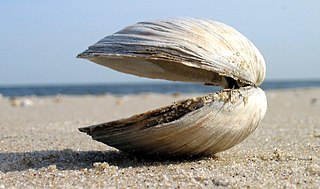
Clam is a common name for several kinds of bivalve molluscs. The word is often applied only to those that are edible and live as infauna, spending most of their lives halfway buried in the sand of the seafloor or riverbeds. Clams have two shells of equal size connected by two adductor muscles and have a powerful burrowing foot. They live in both freshwater and marine environments; in salt water they prefer to burrow down into the mud and the turbidity of the water required varies with species and location; the greatest diversity of these is in North America.

A cockle is an edible, marine bivalve mollusc. Although many small edible bivalves are loosely called cockles, true cockles are species in the family Cardiidae. True cockles live in sandy, sheltered beaches throughout the world. The distinctive rounded shells are bilaterally symmetrical, and are heart-shaped when viewed from the end. Numerous radial, evenly spaced ribs are a feature of the shell in most but not all genera.

Anadara is a genus of saltwater bivalves, ark clams, in the family Arcidae. It is also called Scapharca.
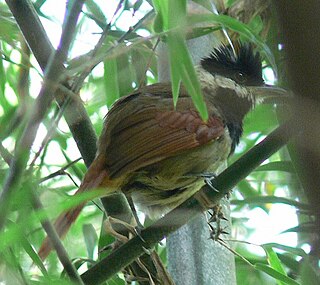
The white-bearded antshrike is a species of bird in the family Thamnophilidae, the only member of the genus Biatas. It is endemic to the Atlantic forest of Argentina and Brazil.
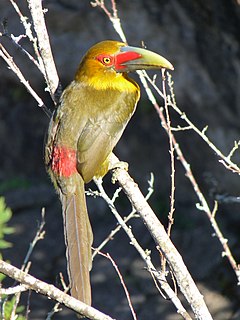
The saffron toucanet is a species of bird in the family Ramphastidae found in the Atlantic Forest in far north-eastern Argentina, south-eastern Brazil, and eastern Paraguay.

The common cockle is a species of edible saltwater clam, a marine bivalve mollusc in the family Cardiidae, the cockles. It is found in waters off Europe, from Iceland in the north, south into waters off western Africa as far south as Senegal. The ribbed oval shells can reach 6 centimetres (2.4 in) across and are white, yellowish or brown in colour. The common cockle is harvested commercially and eaten in much of its range.

Cerastoderma is a genus of marine bivalves in the family Cardiidae. It includes the common cockle Cerastoderma edule.
Protocardia is an extinct genus of saltwater clams, marine bivalve mollusks in the family Cardiidae, the cockles. The internal anatomy of individuals in this genus is sometimes preserved in phosphate.

Trachycardium is a genus of molluscs in the family Cardiidae.
Americardia media, the Atlantic strawberry cockle, is a species of saltwater clam, a marine bivalve mollusc in the family Cardiidae, the cockles. This species can be found along the Atlantic coast of North America, from Cape Hatteras to the West Indies.

Clinocardium is a genus of molluscs in the family Cardiidae.
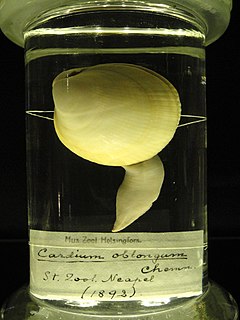
Laevicardium, common name "egg cockles", is a genus of saltwater clams or cockles, marine bivalve molluscs in the family Cardiidae, the cockles. They are unusual among the cockles in that they have smooth, rounded, "egg-like" valves.
Papyridea is a genus of molluscs in the family Cardiidae.
Serripes is a genus of molluscs in the family Cardiidae.
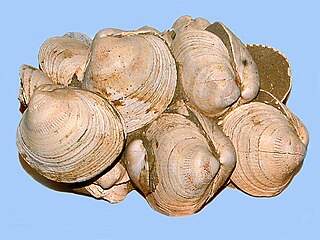
Glycymeris, common name the bittersweet clams, is a genus of saltwater clams, marine bivalve molluscs in the family Glycymerididae.

Dinocardium is a genus of large saltwater clams or cockles, marine bivalve molluscs in the family Cardiidae, the cockles. There is only one species in the genus, Dinocardium robustum, or the Atlantic giant cockle.

Acanthocardia tuberculata, the rough cockle, is a species of saltwater clam, a cockle, a marine bivalve mollusc in the family Cardiidae. The genus Acanthocardia is present from the Upper Oligocene to the Recent.

Acanthocardia aculeata, the spiny cockle, is a species of saltwater clams, marine bivalve molluscs in the family Cardiidae. The genus Acanthocardia is present from the Upper Oligocene to the Recent.

The term cardium comes from the Greek word for 'heart'. It is a frequently encountered term in physiology where it is incorporated into scientific nomenclature.












